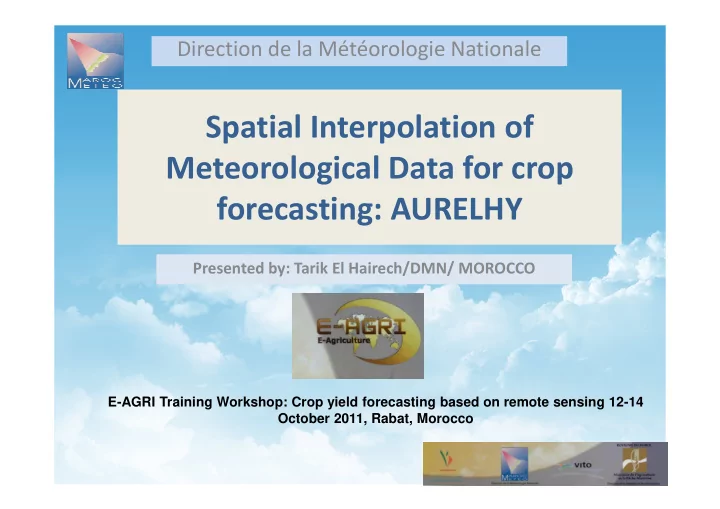

Direction de la Météorologie Nationale Spatial Interpolation of Meteorological Data for crop forecasting: AURELHY Presented by: Tarik El Hairech/DMN/ MOROCCO E-AGRI Training Workshop: Crop yield forecasting based on remote sensing 12-14 October 2011, Rabat, Morocco
Outlines • Origin and theoretical background • Implementation for Morocco • Aurelhy : Adaptation to crop yield • Aurelhy : Adaptation to crop yield forecasting • Perspectives and summary
AURELHY: Origin • AURELHY: A nalyse U tilisant le RE Lief pour les besoins de l’ Hy drométéorologie • Authors: (Patrick Bénichou and Odile Le Breton, 1986) from METEO FRANCE
Aurelhy: Basic Idea • Use of topography to guide the spatial interpolation of climatic variables climatic variables (precipitation and others) P(Si) = P(xi, yi, Ri) = f(Ri) + ε(xi, yi)
AURELHY: Suitability • More suitable for the interpolation of means, deciles, and other Monthly statistics of long time series • Suitable for precipitation, number of rainy days, temperature (max, min, no. of frost days...) Sources: Bénichou and Le Breton, 1986; Ecole nationale de la météorologie, without date; Regimbeau, 2008
Topography effect on Moroccan climate • W/E Gradient • N/S Gradient • Sea Effect Sea Effect • Mountain Barrier
AURELHY: Steps involved • Terrain analysis – Mapping relative altitude differences of smoothed local topographies – PCA of local topography variables • Regression of climate variable against terrain • Regression of climate variable against terrain – Surface predicted by regression • Spatial interpolation of residuals by Kriging • Adding surface of interpolated residuals to surface predicted by regression
Terrain analysis: New geometry adopted � The landscape variables correspond to the difference in elevation difference in elevation between each grid point between each grid point and neighbors points regularly distributed around the grid point (8 sectors and 5 distances from 6 to 26 km.
Terrain analysis: PCA of Local Topography variables From left to right respectively Pc1 to Pc10
Terrain analysis: 10 Pcs explain more than 92% of total variance Local PCA Cumulative Proportion of variance % 1 0.9 0.8 0.7 % of Variance ce 0.6 0.6 0.5 0.4 0.3 0.2 0.1 0 local PCA
Terrain analysis: straightforward interpretation as terrain form Source: Huard, 1990
Regression Issues: Predictors
Regression Issues: Co linearity
Regression Issues: Multi Co Linearity
Regression Issues: Avoiding Multi Co linearity • Use of Stepwise Regression : Backward and Forward elimination � Reduction of predictors number � Ensuring The significance of regression Coefficients � Ensuring The normality of residuals which is an important condition for kriging
Residuals kriging • Compute regression residues and spatially interpolate them with a kriging algorithm to a resolution of 0.1 degree: � Detrend the quadratic drift from regression residues; from regression residues; � Interpolate the detrended term with an ordinary Kriging using a spherical semivariogram;
Final mapping • Final mapping by addition of : – Grid predicted by regression – Grid obtained through – Grid obtained through kriging of residuals
AURELHY Implementation: R package • R Version(>= 2.10.0) • Dependents R Package: stats, graphics, shapefiles, gstat, Mass shapefiles, gstat, Mass • Author: Philippe Grosjean • Download: http://r-forge.r-project.org/projects/aurelhy/
AURELHY R package: Utilities • DEM Resampling to 0.1° • Local Topography components • SEA Distance Calculation • Principal Component Analysis of Local Topography components • FITTING Variogram
Data Needed: DEM and geo referenced Data records
comparison of Two variants of Aurelhy • Variant 1: � Regression of each decadal climatic variable against PCs and kriging residuals • Variant 2: • Variant 2: � Regression of long term average of climatic variable and kriging differences
comparison of Two variants of Aurelhy (Rain)
comparison of Two variants of Aurelhy (Tmax)
comparison of Two variants of Aurelhy (Tmin)
va Regression Residuals analysis ( Tmin) • Regressions in using long term average gives significant models but generates more Fields not following a normal distribution. • GOOD REGRESSIONS BUT VERY LIKELY BAD KRIGING
leave one out Cross Validation ( Temperatures) • Both Variants Presents good and similar results for Temperatures (Tmax and Tmin) Variable Variants R² adj Slope MSE Variant 1 Variant 1 0.95 0.95 0.951 0.951 2.23 2.23 Tmin Tmin Variant 2 0.93 0.9 2.16 Variant 1 0.92 0.998 7.32 Tmax Variant 2 0.91 0.996 7.21
leave one out Cross Validation ( Rainfall) Rainfall: Variant 2 is more stable STANDART DEVIATION OF ERRORS Variant1 Variant2 MEAN MEAN 1.06E+14 1.06E+14 16.9 16.9 MINIMUM 5.01 4.4 MAXIMUM 5.03E+15 264.24
leave one out sensitivity
Role of interpolation in CGMS level 1
Daily Data needed for feeding CGMS maximum temperature ( ° C) minimum temperature ( ° C) mean daily vapour pressure (hPa) mean daily windspeed at 10m (m/s) mean daily rainfall (mm) Penman potential evaporation from a free water surface Penman potential evaporation from a free water surface (mm/day) Penman potential evaporation from a moist bare soil surface (mm/day) Penman potential transpiration from a crop canopy (mm/day) daily global radiation in KJ/m 2 /day daily mean snow depth in cm
Alternative entry for grid weather data • CGM Version 9.2: 1. Integration of Decadal grids of temperatures , rainfalls and number of rainy days by decade number of rainy days by decade or month; 2. Downscaling to Daily time step
Pseudo Penman Formula for ET0 Calculation
Summary • Aurelhy has the potential to integrate the effect of topography for Tmin and Tmax interpolation at 10 days scale. Both variants are reliable. • Using Long term average for precipitations gives stable results. stable results. • Interpolation by Aurelhy needs more development especially for punctual/convective rain events. • Aurelhy is sensitive to the number of stations and their geographic position • Aurelhy is sensitive to Data quality and Data missing
Aurelhy Perspectives for CGMS • Generating decadal grids of Tmax, Tmin , Rain and number of rainy days; • Using the calibrated Hargreaves formula for ET0;
THANK YOU!
Recommend
More recommend